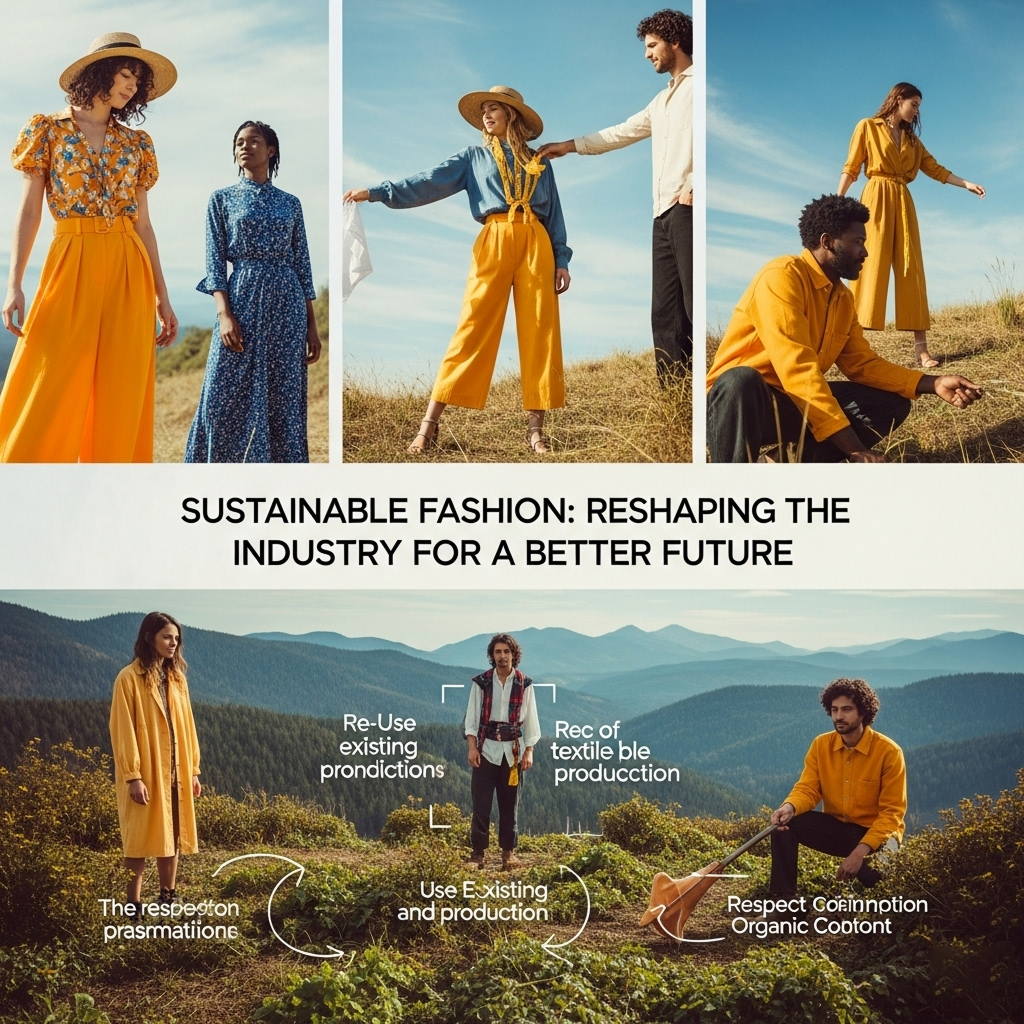Blog
Sustainable Fashion: Reshaping the Industry for a Better Future

The allure of a new outfit at an unbelievably low price is undeniably strong. Fast fashion has, for decades, captivated consumers with its promise of instant gratification and endless trends. Yet, beneath the glossy surface of rapid cycles and tempting price tags lies a stark reality: the fashion industry, particularly its fast-paced segment, is one of the most polluting and exploitative industries on the planet. From immense environmental degradation to dire social injustices, the true cost of our cheap clothes is staggering. However, a powerful movement is gaining momentum: sustainable fashion. This isn’t just a trend; it’s a fundamental reshaping of how clothes are made, consumed, and discarded, aiming for a future where style doesn’t come at the Earth’s expense.
The Problem with Fast Fashion: A Global Crisis
To understand the necessity of sustainable fashion, we must first confront the scale of the fast fashion problem. Its business model thrives on mass production, low costs, and rapid consumption, pushing consumers to buy more, more often. The consequences are dire:
Environmental Devastation:
Water Pollution: Textile dyeing and treatment processes are notorious for discharging toxic chemicals into waterways, contaminating drinking water and destroying aquatic ecosystems. Polyester, a widely used synthetic fiber, is a significant contributor to microplastic pollution in our oceans.
Textile Waste: The average consumer throws away a significant amount of clothing each year, much of which ends up in landfills. Synthetic fabrics can take hundreds of years to decompose, releasing harmful greenhouse gases in the process. Even natural fibers often end up in anaerobic conditions, producing methane.
Carbon Emissions: The entire supply chain, from raw material extraction and manufacturing to transportation and disposal, is incredibly energy-intensive, contributing significantly to global greenhouse gas emissions.
Resource Depletion: Growing conventional cotton requires vast amounts of water and pesticides, depleting water sources and harming soil health and biodiversity.
Social Injustice: The relentless pursuit of lower costs often comes at the expense of human dignity. Workers in garment factories, primarily in developing countries, often face unsafe working conditions, extremely low wages, forced overtime, and a lack of basic labor rights. Child labor and modern slavery are also grim realities in some parts of the supply chain. The Rana Plaza factory collapse in Bangladesh in 2013, which killed over 1,100 garment workers, stands as a chilling reminder of these human costs.
Defining Sustainable Fashion: A Holistic Approach
Sustainable fashion is a broad term encompassing practices and products that are produced, marketed, and consumed in a way that minimizes negative environmental and social impacts. It’s about creating a system that can be maintained indefinitely, without depleting natural resources or harming communities. It shifts the focus from a linear “take-make-dispose” model to a circular economy, emphasizing longevity, resource efficiency, and regeneration.
Key Pillars of Sustainable Fashion
Sustainable fashion isn’t a single solution but a multifaceted approach built on several critical pillars:
Eco-friendly Materials: This involves prioritizing materials that have a lower environmental footprint.
Organic Cotton: Grown without harmful pesticides or synthetic fertilizers, reducing water pollution and promoting soil health.
Recycled Materials: Such as recycled polyester (RPET) made from plastic bottles or recycled cotton, diverting waste from landfills and reducing the need for virgin resources.
Innovative Bio-based Materials: Exciting advancements include fabrics made from wood pulp (Tencel, Lyocell, Modal), hemp, flax (linen), pineapple leaves (Piñatex), mushroom mycelium, and even algae. These often require less water, land, and chemicals.
Closed-Loop Systems: Materials that can be endlessly recycled without losing quality, minimizing waste.
Ethical Production and Fair Labor: This pillar addresses the human cost of fashion.
Fair Wages: Ensuring that garment workers are paid a living wage that covers their basic needs and allows for a decent quality of life.
Safe Working Conditions: Providing factories with proper ventilation, safety equipment, and emergency exits, free from harassment and abuse.
No Child Labor or Forced Labor: Strict adherence to labor laws and ethical sourcing practices throughout the supply chain.
Worker Empowerment: Supporting initiatives that provide workers with a voice, opportunities for education, and collective bargaining rights. Certifications like Fair Trade often signify adherence to these standards.
Circular Economy Principles: Moving beyond just “reducing” and towards a system where resources are kept in use for as long as possible.
Reduce: Encouraging conscious consumption – buying less but buying better quality.
Reuse: Extending the life of garments through resale platforms (like Depop, Poshmark, The RealReal), rental services (for special occasions), and simply wearing clothes for longer.
Repair: Encouraging consumers to mend and repair damaged clothing instead of discarding it. Many brands are now offering repair services.
Recycle: Developing technologies to effectively recycle textiles back into new fibers, minimizing landfill waste. This is still a challenge for mixed-fiber garments.
Upcycling/Repurposing: Transforming old or discarded garments into new, unique pieces, giving them a second life and adding creative value.
Transparency and Traceability: For consumers to make informed choices, brands must be open about their supply chains, from where raw materials are sourced to who makes their clothes and under what conditions. Technologies like blockchain are being explored to enhance this traceability.
Consumer Action: Making a Difference with Your Wardrobe
While systemic change is crucial, individual consumer choices wield significant power. Every purchasing decision is a vote for the kind of fashion industry we want. Here’s how consumers can contribute:
Buy Less, Choose Well: Invest in fewer, higher-quality pieces that will last longer and transcend fleeting trends. Consider a capsule wardrobe approach.
Shop Second-Hand: Embrace thrift stores, vintage shops, consignment stores, and online resale platforms. This is one of the most effective ways to reduce your fashion footprint.
Support Sustainable Brands: Research and choose brands that prioritize ethical and environmental practices. Look for certifications like GOTS (Global Organic Textile Standard), OEKO-TEX, Fair Trade Certified, or B Corp.
Repair and Care for Your Clothes: Learn basic mending skills, or take your damaged garments to a tailor. Follow care labels to extend the life of your clothes (e.g., washing less often, using cold water, air drying).
Rent or Borrow: For special occasions or items you’ll only wear once, consider renting instead of buying.
Educate Yourself: Stay informed about the issues within the fashion industry and share your knowledge with others.
Demand Change: Use your voice as a consumer to pressure brands to adopt more sustainable practices.
Industry Innovations: A Glimpse into the Future
The fashion industry itself is responding to the call for sustainability with exciting innovations:
New Dyeing Technologies: Reducing water and chemical use (e.g., air-dyeing, natural dyes).
Waterless Production Methods: Brands are experimenting with technologies that significantly reduce water consumption in textile manufacturing.
Biotechnology: Developing new fibers from unexpected sources (e.g., lab-grown leather, algae-based pigments).
On-Demand Manufacturing: Producing garments only when they are ordered, reducing overproduction and waste.
Blockchain for Supply Chain Transparency: Creating an immutable record of every step a garment takes from raw material to finished product.
Conclusion: A Collective Responsibility
Sustainable fashion is more than just a niche market; it’s a paradigm shift towards a more responsible and equitable industry. It recognizes that our clothes are connected to a vast global network of resources, labor, and ecosystems. While the challenges are immense, the growing awareness among consumers, coupled with innovative solutions from brands and designers, offers a hopeful vision. By collectively rethinking our relationship with fashion – valuing quality over quantity, ethics over fleeting trends, and longevity over disposability – we can weave a future where style and sustainability are not mutually exclusive, but intricately intertwined for the benefit of both people and the planet.
